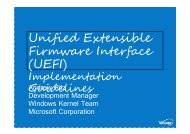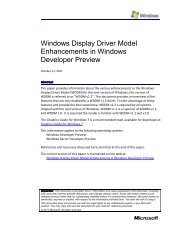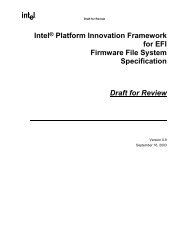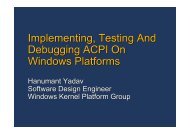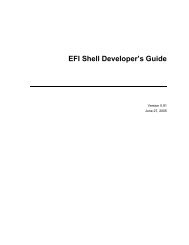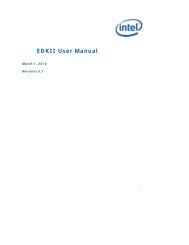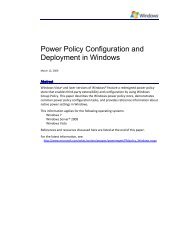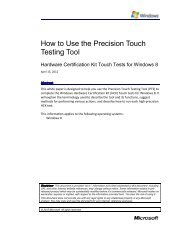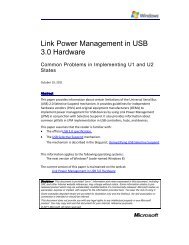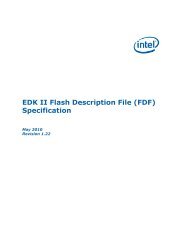TPM - Trusted Platform Module
TPM - Trusted Platform Module
TPM - Trusted Platform Module
- No tags were found...
Create successful ePaper yourself
Turn your PDF publications into a flip-book with our unique Google optimized e-Paper software.
Overview●●●●●●●●●●MotivationTC and <strong>TPM</strong> Design Goals<strong>TPM</strong> Overview and <strong>TPM</strong> Specification<strong>TPM</strong> InternalsTaking and Clearing <strong>TPM</strong> Ownership<strong>TPM</strong> Keys, Key Creation and Key HierarchyRoots of Trust (RTM, RTR, RTS)AttestationLow-level <strong>TPM</strong> InteractionAdvanced <strong>TPM</strong> Concepts<strong>Trusted</strong> Computing Labs, IAIK TU Graz 2
Motivation●●●hundred millions of PCs, laptops, ... shipped with a <strong>TPM</strong>many misconceptions and misunderstandingsWhat have you heard about <strong>TPM</strong>s?– Do you have a machine with a <strong>TPM</strong>?– Are you using it?– What do you think itdoes?– What do you thinkit can be used for?<strong>Trusted</strong> Computing Labs, IAIK TU Graz 3
TC and <strong>TPM</strong> Design Goals●A trusted system is one that “behaves in the expected manner fora particular purpose” (TCG).– How can that be achieved? Whom can you trust? The OS?– Would you trust your OS to be unmodified? If so - why?●●●– If you don't know for sure that your OS really is in the state itclaims to be - why trust any software running on top of it?How can one report the system state to a third party?Assumption: Much easier to manipulate software than hardware.– Idea of TC: implement trust anchor in hardware -> <strong>TPM</strong><strong>TPM</strong>s are designed to be relatively low cost devices– limited resistance against sophisticated hardware attacks– not perfect security but better than pure software solution<strong>Trusted</strong> Computing Labs, IAIK TU Graz 4
<strong>TPM</strong> Overview●●●<strong>TPM</strong> spec is not targeted towards a specific deviceother specs such as the PC Client or Mobile Phone Spec"customize" the <strong>TPM</strong> spec for a specific device<strong>TPM</strong> Manufacturers (in no particular order)– Infineon– Intel– Atmel– ST Microelectronics– Winbond (bought business unit from National Semiconductors)– Broadcom– SinoSun (China)<strong>Trusted</strong> Computing Labs, IAIK TU Graz 7
<strong>TPM</strong> Specification●TCG <strong>TPM</strong> spec for 1.2 consists of 4 parts (700+ pages total)– Part 1: Design Principles Part 2: Structures and ConstantsPart 3: Commands Part 4: Compliance– all structures and commands are specified in C like syntax– additional platform specific spec (e.g. PC)– spec says nothing about internal <strong>TPM</strong> design or speed requirements<strong>Trusted</strong> Computing Labs, IAIK TU Graz images © by TCG (<strong>TPM</strong> specification) 8
<strong>TPM</strong> Internals●●●●●●●shielded location: an area where data is protected againstinterference from the outside and exposureprotected capability: a function whose correct operation isnecessary in order for the operation of the TCG subsystem to betrustedonly protected capabilities operate on data in shielded locationsboth, shielded locations and protected capabilities areimplemented in hardware and therefore resistant againstsoftware attacks<strong>TPM</strong> is a slave device that does not actively initiatecommunication<strong>TPM</strong> has no access to any system resources (LPC bus limitation)consequence: <strong>TPM</strong> can not alter execution flow of system (e.g.booting, execution of applications, ...)<strong>Trusted</strong> Computing Labs, IAIK TU Graz 9
<strong>TPM</strong> Internals●I/O– manages information flow over the communications bus– typically LPC - Low PinCount Bus, SM-Bus●Execution Engine– command verification and parsing– execution of the appropriate command code– controls internal <strong>TPM</strong> execution flow– micro-controller<strong>Trusted</strong> Computing Labs, IAIK TU Graz 10
<strong>TPM</strong> Internals●SHA-1 Engine (160 bits)– primarily used by the <strong>TPM</strong> as its trusted hash algorithm– exposed to the outside to be used in the boot process– <strong>TPM</strong> is not a crypto accelerator– future <strong>TPM</strong> revisions likely to add additional hash functions●RNG– source of randomness in the <strong>TPM</strong>– used for nonces (Number Used Once), key generation, ...<strong>Trusted</strong> Computing Labs, IAIK TU Graz 11
<strong>TPM</strong> Internals - RSA●RSA Engine and Key Generator– asymmetric key generation (RSA; storage and AIK key size >= 2048)– must support 512, 1024, 2048 bit keys– use of 2048 recommended– RSA public exponent is fixed to 2^16 + 1– asymmetric encryption/decryption (RSA)– optionally may implement DSA, ECC (but no known implementation)– to use an RSA key it has to be loaded into the <strong>TPM</strong><strong>Trusted</strong> Computing Labs, IAIK TU Graz 12
<strong>TPM</strong> Internals●<strong>Platform</strong> Configuration Registers (PCRs)– PCR is a 160 bit storage location for integrity measurements– shielded location inside <strong>TPM</strong>– values are not set or overwritten but extendedPCR[i] = SHA-1(PCR[i] || newMeasurement)– PCR extends are not commutative (i.e. measuring A then B does notresult in the same PCR value as measuring B then A)– PCRs can keep track of unlimited number of measurements– <strong>TPM</strong> 1.2: 24 PCRs (<strong>TPM</strong> 1.1: 16 PCRs)– static PCRs: reset only at boot time– dynamic PCRs: PCRs above index 16●reset can only be triggered by somesecure mechanism (DRTM startup)<strong>Trusted</strong> Computing Labs, IAIK TU Graz 13
<strong>TPM</strong> Internals●●Volatile Memory– key slots: to use a <strong>TPM</strong> key it has to be loaded into the <strong>TPM</strong>(remember: protected capabilities operate on shielded locations)Non-Volatile Memory– special keys (Endorsement Key (EK) and Storage Root Key (SRK),owner secret, ...– Endorsement Key Certificate (details follow in later lecture)●Opt-In: <strong>Platform</strong> owner can decide whether or not he wants tomake use of the <strong>TPM</strong><strong>Trusted</strong> Computing Labs, IAIK TU Graz 14
<strong>TPM</strong> Internals●Power Detection– <strong>TPM</strong> must be notified of all power changes– at some point in POST <strong>TPM</strong> gets notified that actions that require“physical presence” have to be disabled●Symmetric Encryption for secrets– XOR with emphemeral session secret●HMAC Engine– keyed hash function– proof of authentication data knowledge (secret = HMAC key)– proof that received command was not modified (integrity)<strong>Trusted</strong> Computing Labs, IAIK TU Graz 15
Taking Ownership of a <strong>TPM</strong>●●●●●<strong>TPM</strong> is shipped in "unowned" stateto make proper use of <strong>TPM</strong>, platform owner has to execute"TakeOwnership" operationsetting owner password - inserting a shared secret into the <strong>TPM</strong>(stored in shielded location; non volatile memory)certain <strong>TPM</strong> operations require owner authorization“physical presence” allows access to certain (otherwise ownerprotected) <strong>TPM</strong> functionality; does not reveal any <strong>TPM</strong> secrets– ForceClear allows to "clear" the <strong>TPM</strong> using physical presence●●●Storage Root Key (SRK) is created as part of TakeOwnership(private) SRK is stored inside the <strong>TPM</strong> and never leaves itpassword required for SRK usage can be set<strong>Trusted</strong> Computing Labs, IAIK TU Graz 16
Clearing a <strong>TPM</strong>●●●●resetting the <strong>TPM</strong> to the factory defaultsclearing requires owner secret or physical presence (ForceClear)there are no mechanisms to recover a lost <strong>TPM</strong> owner passwordtasks executed when clearing the <strong>TPM</strong>– invalidation of the SRK and thereby all data protected by the SRK(there simply is no way to decrypt the data blobs anymore)– invalidation of the <strong>TPM</strong> owner authorization value– reset of volatile and non-volatile memory to factory defaults– EK is NOT affected– PCR values are undefined after clear (reboot required)●●ForceClear is only available during boot (and disabled thereafter)OwnerClear can also be disabled (permanent; ForceClearrequired)<strong>Trusted</strong> Computing Labs, IAIK TU Graz 17
<strong>TPM</strong> BIOS control●●TCG compliant BIOS allows to ForceClear a <strong>TPM</strong>TCG compliant BIOS allows to change <strong>TPM</strong> status(disabled/enabled)<strong>Trusted</strong> Computing Labs, IAIK TU Graz 18
<strong>TPM</strong> Keys●Endorsement key (EK)– unique platform identity– details are discussed later in the context of AIKs and Attestation●Storage Root Key (SRK)– 2048 bit RSA key– is top level element of <strong>TPM</strong> key hierarchy●●Storage Keys– RSA keys used to wrap (encrypt) other elements in the <strong>TPM</strong> keyhierarchySignature Keys– RSA keys used for signing operations– must be a leaf in the <strong>TPM</strong> key hierarchy<strong>Trusted</strong> Computing Labs, IAIK TU Graz 19
<strong>TPM</strong> Keys●Binding Keys– key used for binding operations (<strong>TPM</strong>_Bind, <strong>TPM</strong>_Unbind)●Legacy Keys– can be used for both, signing and binding– usage of this type of key is not recommended(use keys tagged for the specific purpose instead)●Protection of Keys– usage secret: has to be provided for all operations that make use ofa <strong>TPM</strong> key– migration secret: has to be provided when migrating a key betweendifferent platforms<strong>Trusted</strong> Computing Labs, IAIK TU Graz 20
Creating <strong>TPM</strong> Keys●●●Endorsement Key and Storage Root Key are the only keyspermanently stored inside the <strong>TPM</strong><strong>TPM</strong> keys are generated inside the <strong>TPM</strong>to use a <strong>TPM</strong> key, it has to be loaded into the <strong>TPM</strong>●●amount of <strong>TPM</strong> key slots is limitedmanagement of key slots is done in software (TSS)<strong>Trusted</strong> Computing Labs, IAIK TU Graz 21
Creating <strong>TPM</strong> Keys●●●RSA Engine creates a new RSA keyto create a key pair, a parent key has to be specifiedamount of key slots inside the <strong>TPM</strong> is limited -> a mechanism isrequired to (securely) swap out keys from the <strong>TPM</strong>●if a key is exported from the <strong>TPM</strong> its private part never leaves the<strong>TPM</strong> in plain: it is encrypted with its public parent key<strong>Trusted</strong> Computing Labs, IAIK TU Graz 22
<strong>TPM</strong> Key Hierarchy●When moving out keys from a <strong>TPM</strong> a key hierarchy is established.●Whenever a key is exported from the <strong>TPM</strong>, its private part isencrypted using the public key of the parent.In TCG terminology the child key is wrapped using the parent key.●Since the parents private key (required to load/decrypt the childkey) never leaves the <strong>TPM</strong> in plain, the private key of a <strong>TPM</strong> cannever be decrypted/used outside of the <strong>TPM</strong>.●The private SRK, sitting at the top level of the key hierarchy, isnever exported from the <strong>TPM</strong>.●Storage keys form the nodes of the key hierarchy while signingkeys always are leaves.<strong>Trusted</strong> Computing Labs, IAIK TU Graz 23
<strong>TPM</strong> Key Hierarchy●●key hierarchy withSRK as rootprivate SRK neverleaves the <strong>TPM</strong><strong>Trusted</strong> Computing Labs, IAIK TU Graz 24
Unloading <strong>TPM</strong> Keys●●exporting key blobfrom <strong>TPM</strong>private part isencrypted withpublic parent keybefore key blobleaves <strong>TPM</strong><strong>Trusted</strong> Computing Labs, IAIK TU Graz 25
Loading <strong>TPM</strong> Keys●●task: load signing key into<strong>TPM</strong> to use it for signingoperationestablish entire key chainup to SRK<strong>Trusted</strong> Computing Labs, IAIK TU Graz 26
Loading <strong>TPM</strong> Keys●●decrypt private key ofstorage key #1 using theprivate SRKrequires SRK usagesecret<strong>Trusted</strong> Computing Labs, IAIK TU Graz 27
Loading <strong>TPM</strong> Keys●●decrypt private key ofstorage key #2 using thestorage key #1requires key #1 usagesecret<strong>Trusted</strong> Computing Labs, IAIK TU Graz 28
Loading <strong>TPM</strong> Keys●●decrypt private key ofsigning key using thestorage key #2requires key #2 usagesecret<strong>Trusted</strong> Computing Labs, IAIK TU Graz 29
Roots of Trust●●Root of Trust: “a hardware or software mechanism that oneimplicitly trusts”Root of Trust for Measurement (RTM)– uses PCRs to record the state of a system– static entity like the PC BIOS or dynamic entity (e.g. LT)●Root of Trust for Reporting (RTR)– entity trusted to report information accurately and correctly●– uses PCRs and RSA signatures to report the platform state toexternal parties in an unforgeable wayRoot of Trust for Storage (RTS)– entity trusted to store information without interference leakage– uses PCRs and RSA encryption to protect data and ensure that datacan only be accessed if platform is in a known state<strong>Trusted</strong> Computing Labs, IAIK TU Graz 30
Root of Trust for Measurement●●●●●●●goal: measure system state into PCRsusing PCRs a communication party can be convinced thatthe system is in some known statesystem users are NOT prevented from running any softwarethey wantbut the execution is logged and can not be deniedproblem: some anchor is needed to start the measurementsfrom -> Root of Trust for Measurementstatic RTM: part of the BIOSdynamic RTM: provided by technologies such as LaGrande(Intel) or Pacifica (AMD)<strong>Trusted</strong> Computing Labs, IAIK TU Graz 31
Root of Trust for Measurement●●From the RTM the trust is extended to other system components.This concept is called transitive trust.involved steps:– measure (compute the hash value of) the next entity: e.g. the BIOSmeasures the OS loader– the measurement is extended into one of the <strong>TPM</strong>s PCRs– control is passes to the measured entity●●●●This process is continued for all components of a system up touser level applications.PC client specifications defines which PCRs are used for whatnote 1: measurements change with system updates and patchesnote 2: number of measurements can get very large (already foraverage systems)<strong>Trusted</strong> Computing Labs, IAIK TU Graz 32
Chain of Trust<strong>Trusted</strong> Computing Labs, IAIK TU Graz 33
PCR Event Log●●●●Together with PCR extensions also PCR event log entries can bemade.A log entry contains the PCR number, the value that wasextended into the PCR and a log message (giving details whatwas measured).The event log does not need to be protected by the <strong>TPM</strong> andtherefore is managed on external mass storage (managed byTSS).The event log can be used to validate the individual steps thatlead to the current PCR value.– calculate the extends in software starting at the beginning of the log– compare the result to the PCR value in the <strong>TPM</strong>– if the values match the verifier has assurance that the log was nottampered with<strong>Trusted</strong> Computing Labs, IAIK TU Graz 34
Measurement Log●Example: Integrity Measurement Architecture (IMA) on Linux boot<strong>Trusted</strong> Computing Labs, IAIK TU Graz 35
Root of Trust for Reporting●●RTR is a mechanism to securely report that state of a platform toa third party. The idea is to digitally sign the PCR values insidethe <strong>TPM</strong> and send the signature to the requester.Endorsement Key (EK) forms the Root of Trust for Reporting (RTR)– 2048 bit RSA key contained inside the <strong>TPM</strong>– private part never leaves the <strong>TPM</strong> (only exists in shielded location)– EK is unique for every <strong>TPM</strong> and therefore uniquely identifies a <strong>TPM</strong>– typically generated by <strong>TPM</strong> manufacturer in the fab, either inside the<strong>TPM</strong> or generated off-chip and then injected (private EK is exposed)– The EK is backed by an EK certificate typically issued by the <strong>TPM</strong>manufacturer. The EK certificate guarantees that the key actually isan EK and is protected by a genuine <strong>TPM</strong>.– EK can not be changed or removed<strong>Trusted</strong> Computing Labs, IAIK TU Graz 36
Attestation Identity Keys●●●●Uniqueness of the EK would be a privacy problem if the EK wereused directly in digital signature operations. All signatures donewith the EK could be tracked back to one single machine.Therefore signing the PCRs using the EK and thereby proving thatthe PCR values are protected by a <strong>TPM</strong> is not an option.Attestation Identity Keys (AIKs) have been introduced as aliaskeys for the EK. The AIKs are designed to provide privacy tousers.Attestation Identity Keys (AIKs)– 2048 bit RSA keys– provides a mechanism to ensure that one is communicating with a<strong>TPM</strong>, but not which <strong>TPM</strong>– signature key that signs only information generated inside the <strong>TPM</strong>– number of AIKs is not limited<strong>Trusted</strong> Computing Labs, IAIK TU Graz 37
Obtaining AIKs●●●●when signing data with an AIK, the verifier wants assurance thatthe key is a <strong>TPM</strong> protected keyAIKs are backed by a certificate that vouches for the fact that theAIK is such a <strong>TPM</strong> protected keyPrivacy CA: trusted third party that issues certificates for AIKsbasic AIK cycle– creates AIK key inside the <strong>TPM</strong>– AIK request data plus certificates are sent to PrivacyCA– PrivacyCA examines the supplied data– if PrivacyCA is convinced that the AIK is a <strong>TPM</strong> key it issues acertificate stating that fact<strong>Trusted</strong> Computing Labs, IAIK TU Graz 38
Basic AIK cycle●●client creates a new AIKkey pair inside the <strong>TPM</strong>(<strong>TPM</strong>_MakeIdentity)TSS assembles AIK request– <strong>TPM</strong> EK certificate– public AIK– ...●●●AIK request is encryptedwith public key of PCAPrivacyCA validates the AIKrequest; checks EK certificate, ... If PCA is convinced that the AIKis a proper <strong>TPM</strong> key, it issues an AIK certificate. PCA response isencrypted with public EK -> only the requester can read it.client activates AIK and stores AIK certificate<strong>Trusted</strong> Computing Labs, IAIK TU Graz 39
Attestation●●goal: prove to an outside entity that the system is in a specificstateinvolved steps– requester specifies the set of PCRs he is interested in and supplies anonce– client digitally signs the requested PCRs and the nonce inside the<strong>TPM</strong> using an AIK– signed data plus AIK certificate are sent to requester– requester checks the digital signature (using AIK certificate) and thenonce (to ensure freshness)– requester contacts PrivacyCA to determine the state of the AIKcertificate– depending on the outcome (PCRs as expected by the requester,signature key is a <strong>TPM</strong> key, ...) requester decides if he wants tocommunicate with the client or not<strong>Trusted</strong> Computing Labs, IAIK TU Graz 40
Attestation<strong>Trusted</strong> Computing Labs, IAIK TU Graz 41
Certifying Keys●●certifying keys = <strong>TPM</strong> makes statement that “this key is held in a<strong>TPM</strong>-shielded location, and it will never be revealed” (when usingan AIK to certify the key!)– certifying essentially means to sign the hash of the public key andrelated key parametersAIKs can certify only non-migratable keys (exception CMKs)– challenger must trust the <strong>TPM</strong> manufacturer●– to validate a certified key the AIK credential can be used (verifierhas to trust the policy of the PrivacyCA)– for keys certified with an AIK, the user can ask a CA to issue acertificate with a special extensionnormal singing keys and legacy keys can certify migratable andnon-migratable keys– usefulness of this type of certification highly depends on the trust inthe signing/legacy key<strong>Trusted</strong> Computing Labs, IAIK TU Graz 42
Root of Trust for Storage●●use of <strong>TPM</strong> keys for encrypting data and keystwo flavors:– without using PCRs: bind/unbind– with using PCRs: seal/unseal●binding– happens outside of the <strong>TPM</strong>– encrypt data with the public part of a <strong>TPM</strong> key– only the <strong>TPM</strong> the key pair belongs to can decrypt the dataremember: private key can only be used inside the <strong>TPM</strong>– binding to a specific <strong>TPM</strong>: use a non-migratable binding key●unbinding– decryption of bound data inside the <strong>TPM</strong> using the private key<strong>Trusted</strong> Computing Labs, IAIK TU Graz 43
Root of Trust for Storage●sealing– a way to combine measurements (PCR content) and external data– encrypt externally provided data with reference to a specific PCRstate– only the <strong>TPM</strong> that sealed the data can do the unseal (ensured byincluding a nonce that only is known to this specific <strong>TPM</strong>)– PCR values specified do not have to be the platforms current PCRvalues but can be some other (future) PCR values– using a storage key (or legacy key)●unsealing– load key that was used for sealing into <strong>TPM</strong>– decrypt sealed blob inside <strong>TPM</strong><strong>Trusted</strong> Computing Labs, IAIK TU Graz 44
Root of Trust for Storage●unsealing (cont.)– <strong>TPM</strong> checks the tpmProof included in the internal data: if the noncedoes not match the one of the <strong>TPM</strong> it returns an error– if the specified PCR values do not match the platforms current PCRvalues an error is returned<strong>Trusted</strong> Computing Labs, IAIK TU Graz 45
PCRs revisited●Summary of PCR usage scenarios– attestation of platform state (<strong>TPM</strong>_Quote)– protecting data (<strong>TPM</strong>_Seal/<strong>TPM</strong>_Unseal)●●– specify set of PCRs upon key creation: key is only usable if thesePCRs are presentCollection of measurements is done outside of the <strong>TPM</strong> by theplatform (chain of trust starting at the RTM).problematic issues:– chain must not be broken– what to measure (binaries, configuration files, scripts, ...)– how to handle system updates?– pool of measurement values can become very large●field of ongoing research (e.g. property based attestation)<strong>Trusted</strong> Computing Labs, IAIK TU Graz 46
Low-Level <strong>TPM</strong> Interaction●<strong>TPM</strong> specification defines a set of basic and complex types– definitions are in C style– primitive types: BYTE, BOOL, UINT16, UINT32– complex types are defined as C structures(typically prefixed with <strong>TPM</strong>_ (in spec 1.2) or TCPA_ (in spec 1.1))– all type definitions, structures, constants and error codes are locatedin part 2 of the specification●●<strong>TPM</strong> has a byte stream oriented interface, meaning that allcommands are serialized into byte arrays which are sent to the<strong>TPM</strong>. The <strong>TPM</strong> response again is a byte stream that has to beparsed.The typical (and only) system entity directly accessing the <strong>TPM</strong> isthe TCG Software Stack (TSS).<strong>Trusted</strong> Computing Labs, IAIK TU Graz 47
<strong>TPM</strong> Command/Object Authorization●●●●●●●many commands require the knowledge of authorization datatypically not commands themselves require authorization but theobjects the commands operate on (e.g. keys, encrypted data)some commands require owner authorization20 bytes shared secret (SHA-1 hash of the password) is requiredto use protected objectssecret is stored together with <strong>TPM</strong> controlled objects in shieldedlocationsowner and SRK secret are stored inside the <strong>TPM</strong>note: <strong>TPM</strong> owner is no “super user” (e.g. has not access to allkeys without knowing their secret)if the owner of an object (e.g. key) can provide the correct secret(authData) it also can execute all <strong>TPM</strong> operations applicable tothat object<strong>Trusted</strong> Computing Labs, IAIK TU Graz 48
<strong>TPM</strong> Authorization Protocols●●<strong>TPM</strong> supports different authorization protocols depending on thespecific purposeOIAP: Object Independent Authorization Protocol– supports authorization for arbitrary entities– session lives indefinitely until it is explicitly terminated●OSAP: Object Specific Authorization Protocol– supports an authentication session of a single entity– enables confidential transmission of new authorization information●●ADIP: Authorization Data Insertion Protocol– used to insert new authorization information during the creation of anew objectadditional protocols to change authorization secrets<strong>Trusted</strong> Computing Labs, IAIK TU Graz 49
Rolling Nonce Paradigm●●●●●●●on session establishment the <strong>TPM</strong> creates a nonce called“nonceEven” which is returned to the clientthe client creates a new nonce called “nonceOdd”the client includes the “nonceEven” received from the <strong>TPM</strong> andits own “nonceOdd” in the next request sent to the <strong>TPM</strong>the <strong>TPM</strong> validates the “nonceEven” contained in the request,creates a new “nonceEven” and includes this new “nonceEven”together with the “nonceOdd” from the client in its responseclient validates the “nonceOdd” received in the response,generates a new “nonceOdd”... and so onSummary: each new input message contains a new nonceOddand each response contains a new nonceEvenrolling nonces are never used on their own but as part of anauthorization protocol<strong>Trusted</strong> Computing Labs, IAIK TU Graz 50
Authorization Data Insertion●●●<strong>TPM</strong> entities such as keys have an associated usage secret (and ifmigratable, a migration secret)when creating a new key, the key secrets must not betransmitted to the <strong>TPM</strong> in plain -> they are XOR encryptedestablish an OSAP session using the parent of the new entityXOR_KEY = SHA1(sharedOSAPsecret || nonceEven)encAuth = XOR(newEntity.secret, XOR_KEY)●●●note: newEntity.secret is the SHA1 hash of the secret provided bythe user (i.e. the <strong>TPM</strong> stores all secrets as SHA1 hashes)The encrypted authorization data (encAuth) is sent to the <strong>TPM</strong> aspart of the <strong>TPM</strong> command that creates the new entity (e.g. key)The <strong>TPM</strong> computes the XOR_KEY the same way and then retrievesthe secret of the new entity, which is stored together with thisentity.<strong>Trusted</strong> Computing Labs, IAIK TU Graz 51
Advanced <strong>TPM</strong> concepts●Overview– Key Migration and Certified Migratable Keys– Monotonic Counters and Timestamping– Non-Volatile Storage– Delegation– Transport Sessions– Maintenance– Localities (covered in later lecture)– Direct Anonymous Attestation (covered in later lecture)●Many of those concepts have been introduced with <strong>TPM</strong>specification 1.2.<strong>Trusted</strong> Computing Labs, IAIK TU Graz 52
<strong>TPM</strong> Key Migration●basic migration scheme (<strong>TPM</strong> 1.1)– migrate RSA keypair KEY_A from <strong>TPM</strong>_A to <strong>TPM</strong>_B– parent of KEY_A is the SRK (i.e. private part of KEY_A is encryptedwith the public SRK of <strong>TPM</strong>_A)– storage key KEY_B of <strong>TPM</strong>_B to become new parent of KEY_A– prepare KEY_B by calling <strong>TPM</strong>_AuthorizeMigrationKey on <strong>TPM</strong>_B– transport the resulting public key structure to <strong>TPM</strong>_A– call <strong>TPM</strong>_CreateMigrationBlob using the public part of KEY_B on<strong>TPM</strong>_A– <strong>TPM</strong>_A internally re-wraps KEY_A: decryption of the private part ofKEY_A using the private SRK and then encrypting using the publicpart of KEY_B (requires knowledge of migration secret of KEY_A)– re-wrapped KEY_A can now be loaded into <strong>TPM</strong>_B (unwrapping it withits new parent: KEY_B)<strong>Trusted</strong> Computing Labs, IAIK TU Graz 53
Basic <strong>TPM</strong> Key Migration at a Glance●●●1 – transfer public part of KEY_B to <strong>TPM</strong>_A2 – re-wrap private part of KEY_A using public part of KEY_B3 – KEY_A can now be loaded into <strong>TPM</strong>_B (KEY_B, its parent, is a key of <strong>TPM</strong>_B)<strong>Trusted</strong> Computing Labs, IAIK TU Graz 54
<strong>TPM</strong> Key Migration●●keys that can not be migrated: EK, SRK, AIKs, Non-MigratableKeysmigratable keys have a migration secret●advanced key migration (<strong>TPM</strong> 1.2)– Certified Migration Keys (CMKs)– requires external 3 rd parties:●●Migration Selection Authority (MSA)Migration Authority (MA)– so far no known implementation of this infrastructure●<strong>TPM</strong> Maintenance: vendor specific migration– optional <strong>TPM</strong> feature; vendor specific; requires owner authorization– allows to export all <strong>TPM</strong> data (migratory and non-migratory data)– never implemented by any manufacturer due to security issues<strong>Trusted</strong> Computing Labs, IAIK TU Graz 55
Monotonic Counters and Timestamps●Monotonic Counter– allows for 7 years of increments every 5 seconds– useful e.g. against replay attacks●Time Stamping– <strong>TPM</strong> offers time stamping mechanism– time stamps are not an universal time clock (UTC) value but thenumber of timer ticks counted by the <strong>TPM</strong>– <strong>TPM</strong> has a tick session (started when <strong>TPM</strong> is powered on)●●tick value, increment rate, session nonce (new at every power cycle)– <strong>TPM</strong>_TickStampBlob takes a digest to be signed with a <strong>TPM</strong> signingkey; current tick value and session nonce are included in signaturemechanism outside the <strong>TPM</strong> is required to associate the tickvalue with an UTC value<strong>Trusted</strong> Computing Labs, IAIK TU Graz 56
Non-Volatile Storage●<strong>TPM</strong> contains protected non-volatile storage●<strong>TPM</strong> Owner can define storage locations and their appropriateaccess protection (e.g. requiring authorization for read/write,coupling access to the platform state, ...).●stored entities addressed using indices●potential usage scenarios:– secure storage for certificates such as EK certificate– storage for early bootup stages where other forms of persistentstorage are not yet available<strong>Trusted</strong> Computing Labs, IAIK TU Graz 57
Transport Sessions●●●a mechanism to protect information sent to and returned fromthe <strong>TPM</strong>data transmitted to/from the <strong>TPM</strong> is encryptedsequence of commands: groups a set of commands and providesa digital signature on all of the commands– these transport logs provide evidence that a series of operationsactually took place inside the <strong>TPM</strong>– may also include timing information of actual execution●exclusive transport sessions: any command outside of the sessioncauses the session to terminate<strong>Trusted</strong> Computing Labs, IAIK TU Graz 58
Further Reading●<strong>Trusted</strong> Computing Group:http://www.trustedcomputinggroup.org/Architecture Overviewhttps://www.trustedcomputinggroup.org/specs/IWG/TCG_1_0_Architecture_Overview.pdf<strong>TPM</strong> Specificationhttps://www.trustedcomputinggroup.org/specs/<strong>TPM</strong>●●<strong>Trusted</strong> Computing SystemeThomas Müller; SpringerThe Intel Safer Computing InitiativeBuilding Blocks for <strong>Trusted</strong> ComputingDavid Grawrock; intel press<strong>Trusted</strong> Computing Labs, IAIK TU Graz 59
Questions?Thank you very muchfor your attention!<strong>Trusted</strong> Computing Labs, IAIK TU Graz 60
Open_TC EC Contract No: IST-027635●The Open_TC project is co-financed by the EC.contract no: IST-027635●If you need further information, please visit ourwebsite www.opentc.net or contact the coordinator:Technikon Forschungs- und Planungsgesellschaft mbHRichard-Wagner-Strasse 7, 9500 Villach, AUSTRIATel. +43 4242 23355 0Fax. +43 4242 23355 77Email coordination@opentc.netThe information in this document is provided “as is”, and no guarantee orwarranty is given that the information is fit for any particular purpose.The user thereof uses the information at its sole risk and liability.<strong>Trusted</strong> Computing Labs, IAIK TU Graz 61



